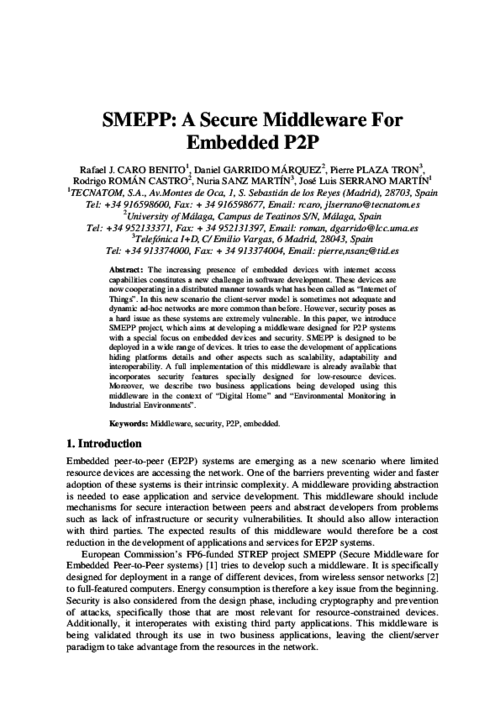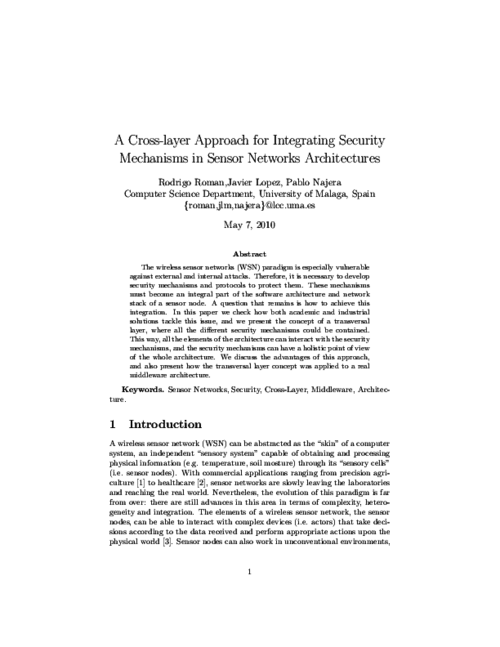SMEPP
Embedded Peer-to-Peer Systems (EP2P) represented an interesting challenge in the development of software for distributed systems. This scenario consisted of systems in which all the heterogeneous elements of the network (sensor nodes, PDAs, PCs) are symmetrical (i.e. all elements can behave as clients or servers) and in most cases, the mechanisms of communication are not based on pre-existing infrastructures. One of the keys in the success of these systems was the possibility to abstract all these problems by means of convenient middleware. The development of such a middleware was actually challenging, since besides the disappearance of the roles of client and server, other critical requirements appeared, which had to be supported by these infrastructures: mobility, discovery and localization protocols, new quality of software criteria, new security problems, etc.
Precisely, the role of NICS in this project was completely focused on the design of the security architecture for the middleware [1], and on the development of the different security mechanisms that should be used by the other elements of the middleware. As a result, we specified a transversal layer that not only retained the benefits of both layered (modularity, interoperability, design longevity) and cross-layered architectures (optimization, tunable design), but also controlled the disadvantages caused by cross-layered systems (hidden dependencies, poor maintainability) [2]. Moreover, we also designed the security mechanisms that allowed the secure management of groups (joining, leaving, information exchanging). Note that the owner of every group was also able to specify the security level of the group (e.g. using pre-shared keys or public key cryptography to enter inside the group).
References
-
"SMEPP: A Secure Middleware for Embedded P2P",
ICT Mobile and Wireless Communications Summit (ICT-MobileSummit’09), June, 2009.
 More..
More..Abstract
The increasing presence of embedded devices with internet access capabilities constitutes a new challenge in software development. These devices are now cooperating in a distributed manner towards what has been called as "Internet of Things". In this new scenario the client-server model is sometimes not adequate and dynamic ad-hoc networks are more common than before. However, security poses as a hard issue as these systems are extremely vulnerable. In this paper, we introduce SMEPP project, which aims at developing a middleware designed for P2P systems with a special focus on embedded devices and security. SMEPP is designed to be deployed in a wide range of devices. It tries to ease the development of applications hiding platforms details and other aspects such as scalability, adaptability and interoperability. A full implementation of this middleware is already available that incorporates security features specially designed for low-resource devices. Moreover, we describe two business applications being developed using this middleware in the context of "Digital Home" and "Environmental Monitoring in Industrial Environments".

-
"A Cross-layer Approach for Integrating Security Mechanisms in Sensor Networks Architectures",
Wireless Communications and Mobile Computing, vol. 11, Wiley, pp. 267-276, 2011. DOI
 (I.F.: 0.884)More..
(I.F.: 0.884)More..Abstract
The wireless sensor networks (WSN) paradigm is especially vulnerable against external and internal attacks. Therefore, it is necessary to develop security mechanisms and protocols to protect them. These mechanisms must become an integral part of the software architecture and network stack of a sensor node. A question that remains is how to achieve this integration. In this paper we check how both academic and industrial solutions tackle this issue, and we present the concept of a transversal layer, where all the different security mechanisms could be contained. This way, all the elements of the architecture can interact with the security mechanisms, and the security mechanisms can have a holistic point of view of the whole architecture. We discuss the advantages of this approach, and also present how the transversal layer concept was applied to a real middleware architecture.
Impact Factor: 0.884Journal Citation Reports® Science Edition (Thomson Reuters, 2011)
